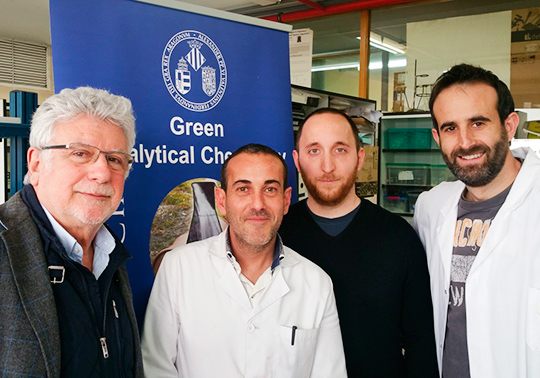Vaping produces three times less emissions of particles than tobacco smoke
- April 8th, 2016

A study of the Department of Analytical Chemistry of the of the Universitat de València has shown that smoking cigarettes and vaping helps to rarefy the environment in close atmospheres, though vaping produces three times less emissions of particle than smoke. The work has been published in the magazine ‘Microchemical Journal’. It gives more data about electronic cigarettes, a product which is advertised as an innocuous alternative to tobacco and a way to stop smoke, but whose security and efficacy are controversial, it is specified.
The research is about the effects of smoking electronic cigarettes and classic cigarettes, and for that has been analysed the air quality in close spaces and the breath of passive smokers in both cases. With devices to monitor the air, has been evaluated the carbon monoxide (CO), carbon dioxide (CO2), particulate material (PM), formaldehyde and volatile organic compounds (COV), which are in indoor air and in the breath of passive smokers and vapers.
So, the emission of carbon monoxide (CO) and volatile organic compounds like benzene, toluene, xylene, spirits or lightweight aldehydes in vapour was 0,5 parts per million (ppm), opposite the 8 ppm of carbon monoxide and 1 ppm of volatile organic compounds emitted by tobacco smoke, according Miguel de la Guardia, a member od the team that developed the research. Parts per million is a measure unit to know the concentration, by calculating the unit of a determinate substance regarding each million of the whole units, in this case milligrams per litre.
Moreover, they have detected formaldehyde- a chemical compound that dissolved in water generates formaldehyde- in levels of 35 ppb (part per billion, in this case micrograms per litre) in the exhalation of vaping apposite the 134 ppb in tobacco smoke.
Among the conclusions of the work -where have been used portable probes of air control- they can confirm that the breath of passive smokers and vapers, before and after the exposition to vapour or to the smoke, registered formaldehyde levels which were under the limit of detection of the technique, the minimum discerned is cero.
Equally, the quantity of particles, CO2, CO and volatile compounds were not modified in the case of passives vapers regarding the ones of their breath in a clean atmosphere. Measures were done in a clean and closed room, of 40 cubic meter, where took place active and passive practices of smoking and vaping during two months.
Despite the anti-smoking laws introduced in lots of countries, the passive smoking is a social problem, according the study. There are scientists preliminary evidences about the presence of chemical products of toxin in the vapour generated by electronic cigarettes (called electronic vaporizers and e-cigars). ‘The consume of cigarettes and the consequences of smoke exposition is a problem of global health; that is that justify the control of this activity in closed areas. Last years, the use of electronic cigarettes in Europe is growing. This product is advertised as an innocuous alternative to tobacco and a way to stop smoke, but whose security and efficacy are controversial’, according the research.
Among the conclusions given by the scientists, the have observed that while levels of particles emitted in the breath of passive smokers increase in a 10.000%, volatile organic compounds did it in a 20%, and they detected carbon monoxide in a level of 1ppm (this compound shouldn’t be in the breath). They haven’t found differences significate statistically in levels of CO2 in the breath of passive smokes before and after the exposition of the smoke of conventional cigarettes.
The work “Preliminary results about the breath of passive smokers and vapers based on the use of portable air monitoring devices” has been publishes in the magazine Microchemical Journal. The researcher has been conducted by professors Miguel de la Guardia and Sergio Armenta, with the researchers Juan Casanova and Daniel Gallart, of the Department of Analytical Chemistry of the Universitat de València.
The research has used portable air monitoring devices which are used to measure the emissions of motors and vehicles and to evaluate the air quality in labour atmospheres too. The work has the funding of the Valencian Government and of the Ministry of Economy and Competitiveness with Funds ERDF.
Quantity of nicotine in saliva of passive smokers
In other work, coordinated by Miguel de la Guardia too, is analysed the quantity of nicotine in saliva of passive smokers, with electronic cigarettes and conventional ones, and is confirmed the exposition of the passive vaper to the nicotine. Nonetheless, in saliva of passive smokers there is a level between 40 and 80 milligrams of nicotine per litre of saliva, while passive vapers have levels between 4 an 8 mg per litre; which supposes seven times less exposition to nicotine.
They have evaluated the composition of the liquids to vape and the passive exposition to different types of tobacco too. ‘This study confirms regarding nicotine in saliva the there is an exposition of the passive vaper, but it is smaller than in passive smokers’, according the researcher.
“Passive exposure to nicotine from e-cigarettes”, evaluates data of passive vapers by comparing its situation with the passive smokers. ‘There are studies of passive vapers, while passive smokers have just a few of them’, indicates Miguel de la Guardia. ‘We were interested in compare the rarefy of the environment in both cases, and with the studies of nicotine in saliva, to compare the incident of this alkaloid in people who don’t smoke’, explains the researcher-
















